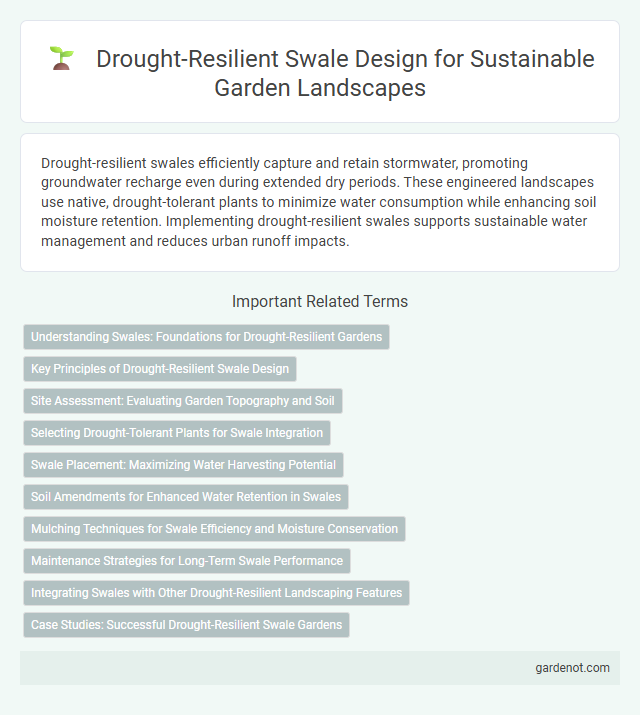Drought-resilient swales efficiently capture and retain stormwater, promoting groundwater recharge even during extended dry periods. These engineered landscapes use native, drought-tolerant plants to minimize water consumption while enhancing soil moisture retention. Implementing drought-resilient swales supports sustainable water management and reduces urban runoff impacts.
Understanding Swales: Foundations for Drought-Resilient Gardens
Swales are landscape features designed to capture and infiltrate water efficiently, reducing runoff and promoting soil moisture retention essential for drought-resilient gardens. By directing water flow into vegetated basins or gentle depressions, swales enhance groundwater recharge and sustain plant health during dry periods. Integrating swales with native, drought-tolerant vegetation further optimizes water use and creates sustainable, resilient garden ecosystems.
Key Principles of Drought-Resilient Swale Design
Drought-resilient swale design prioritizes soil moisture retention through deep infiltration and minimal evaporation, achieved by incorporating organic-rich substrates and mulching. Integrating native drought-tolerant vegetation enhances water uptake efficiency and stabilizes soil structure within the swale system. Strategic grading and oversized storage capacity further ensure sustained water availability during extended dry periods.
Site Assessment: Evaluating Garden Topography and Soil
Assessing garden topography and soil composition is crucial for designing a drought-resilient swale that effectively captures and retains water. Detailed evaluation of slope gradient, soil texture, permeability, and organic matter content ensures optimal water infiltration and minimizes surface runoff during dry periods. Integrating these site-specific factors enhances swale performance in conserving moisture and supporting sustainable landscaping in arid environments.
Selecting Drought-Tolerant Plants for Swale Integration
Selecting drought-tolerant plants such as native grasses, succulents, and deep-rooted perennials enhances swale performance by minimizing water requirements during dry periods. These species improve soil retention and promote infiltration while reducing maintenance needs and irrigation costs. Integrating plants like lavender, sedum, and blue grama supports resilient swale ecosystems capable of withstanding prolonged drought conditions.
Swale Placement: Maximizing Water Harvesting Potential
Strategic swale placement on contour lines enhances water infiltration and minimizes runoff by capturing rainwater efficiently in drought-prone areas. Positioning swales in locations with optimal slope and soil permeability maximizes their water-harvesting potential, supporting vegetation and groundwater recharge. Properly sited swales contribute significantly to landscape resilience by stabilizing soils and maintaining moisture levels during extended dry periods.
Soil Amendments for Enhanced Water Retention in Swales
Soil amendments such as biochar, organic compost, and hydrogels significantly improve water retention in drought-resilient swales by enhancing soil structure and increasing porosity. These amendments help retain moisture longer, reducing irrigation needs and supporting healthy vegetation growth during dry periods. Integrating soil amendments into swale design optimizes water conservation and promotes sustainable landscape management in arid environments.
Mulching Techniques for Swale Efficiency and Moisture Conservation
Mulching techniques enhance drought-resilient swale performance by conserving soil moisture and reducing evaporation rates, crucial for maintaining vegetation health during dry periods. Organic mulches like straw, wood chips, and compost improve water retention, soil structure, and nutrient availability within the swale system. Proper mulch thickness and regular replenishment maximize infiltration and minimize weed competition, thereby optimizing swale efficiency in arid environments.
Maintenance Strategies for Long-Term Swale Performance
Drought-resilient swales require regular inspection and sediment removal to maintain optimal infiltration rates and prevent clogging. Strategic planting of native, drought-tolerant vegetation reduces irrigation needs while stabilizing soil and enhancing pollutant filtration. Implementing adaptive maintenance schedules based on seasonal weather patterns ensures swale functionality during prolonged dry periods.
Integrating Swales with Other Drought-Resilient Landscaping Features
Drought-resilient swales effectively capture and infiltrate rainwater, reducing runoff while supporting native drought-tolerant plants such as succulents and deep-rooted grasses. Integrating swales with permeable pavements and rain gardens enhances water retention and soil moisture levels, creating a synergistic effect for sustainable landscaping. Combining these features promotes biodiversity and reduces irrigation needs, ensuring long-term resilience in arid environments.
Case Studies: Successful Drought-Resilient Swale Gardens
Case studies of drought-resilient swale gardens demonstrate significant water retention and improved soil moisture in arid environments, such as the innovative projects in California's Central Valley and Australia's Murray-Darling Basin. These swales utilize native drought-tolerant vegetation and strategic contouring to maximize infiltration and reduce surface runoff, resulting in enhanced plant survival rates during prolonged dry periods. Monitoring data from these installations reveal a 40-60% increase in soil moisture retention compared to conventional landscaping methods, underscoring the effectiveness of swale designs in mitigating drought impacts.
Drought-resilient swale Infographic

 gardenot.com
gardenot.com